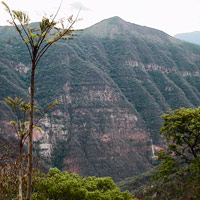Latin America & the Caribbean
Argentina

- © UNESCO
- Las Yungas Biosphere Reserve, Argentina
The country is covered by the UNESCO Cluster Office in Montevideo, Uruguay.
Argentina participates in a great variety of science initiatives, and contributes considerably to earth sciences research projects.
One of the projects it is currently involved in focuses on the integrated management of the coastal area of the Río de la Plata and promotes the sustainable use of coastal resources. This Sustainable Development in Coastal Regions and Small Islands (CSI) project brings together stakeholders at all levels to tackle conflict resolution over resource use, environmental protection and the restoration of degraded areas.
Below you can access the projects that are currently being implemented in the country within the framework of UNESCO’s Natural Sciences Sector.
Freshwater
- World Water Assessment Programme (WWAP) La Plata River Basin case study More
- International Hydrological Programme-Latin America and the Caribbean (IHP-LAC) Working group on snow and ice More
People, Biodiversity and Ecology
- Satellite Imagery for Biodiversity Conservation of World Heritage National Parks of Iguazu and Iguaçu More
- Biosphere Reserves (WNBRs)
- UNESCO-Cousteau Ecotechnie Chair, established in 1998 at General San Martín National University More
Earth Sciences
- Triassic Time and Trans-Panthalassan Correlations (IGCP, Project 467)
- GIS metallogeny of Central Asia (IGCP, Project 473)
- Quaternary Land-Ocean Interactions(IGCP, Project 495)
- The Rheic Ocean: Its origin, evolution, and correlatives (IGCP, Project 497)
- Devonian land-sea interaction: evolution of ecosystems and climate (IGCP, Project 499)
- Global Comparison of Volcanic-hosted Massive Sulphide Districts (IGCP, Project 502)
- Ordovician palaeogeography and palaeoclimate International Geosciences Programme (IGCP, Project 503)
- Marine and Non-marine Jurassic: Global correlation and major geological events (IGCP, Project 506)
- Volcano collapse and fault activity – ‘Young Scientists Project’ (IGCP, Project 508)
- Global correlation of A-type granites and related rocks, their mineralization, and significance in lithospheric evolution (IGCP, Project 510)
- Neoproterozoic Ice Ages (IGCP, Project 512)
- Hydrogeology, Hydrochemistry and Management of Coastal Aquifers on the Atlantic Coast of South America (IGCP, Project 519)
- Global Ground Water Network GROWNET (IGCP, Project 523)
Basic Sciences
- Women, Science, Technology and Development Network More
- UNESCO Chair on Science and Technology Indicators, established in 1996 at the National University of Quilmes More
- UNESCO Chair of Bioethics, established in 1994 at the University of Buenos Aires More
- UNESCO Chair in Biophysics and molecular neurobiology, established in 1998 at the National University of the South More
- UNESCO Chair on Gender, Sciences and Technology, established in 2001 at the Facultad Latinoamericana de Ciencias Sociales (FLASCO) More
- UNESCO-AUGM Chair in Microelectronics, established in 1995 at the National University of Rosario, within the framework of AUGM More
Science Policy and Sustainable Development
- UNESCO Interdisciplinary Chair / Network for Sustainable Development, established in 1995 at the Foro Latinoamericano de Ciencias Ambientales (FLACAM) More
Coasts and Small Islands
- Integrated coastal management, Rio de la Plata. Uruguay (ECOPLATA)
Women in Science
- Professor Ana Belén ELGOYHEN (Argentina), L'Oréal-UNESCO Laureate 2008 for Latin America. For her contribution to the understanding of the molecular basis of hearing. She is best known for having identified and characterized the specialized nerve receptors in the inner ear that modulate, or "remix," the sounds heard by the ear in a way that makes them understandable.

